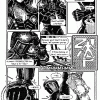By 1988-1990 these technologies were quite advanced, and Athanas, Gillis and Saenz were working at the edge of what was technologically possible and finding new uses for tools that were not originally intended for that purpose. In terms of theme and aesthetics, Shatter was groundbreaking but in retrospect the artwork is unavoidably a sign of its times. Like many other comics being published at the time in America, the UK and Europe, it shared and continued the influence of cyberpunk aesthetics, as made famous by William Gibson’s Neuromancer, published in 1984. As seen on the second image above, the dot-matrix style of Shatter made no attempt to hide the technical limitations of the computer; on the contrary, what Saenz and the artists that followed him wanted to do was to emphasize as much as possible the computerised nature of the creative process. The style echoed Gibson’s definition of “cyberspace” in Neuromancer: (via Un-holy Alliance: Shatter and the aesthetics of cyberpunk | The Comics Grid: Journal of Comics Scholarship | Ernesto Priego
)
